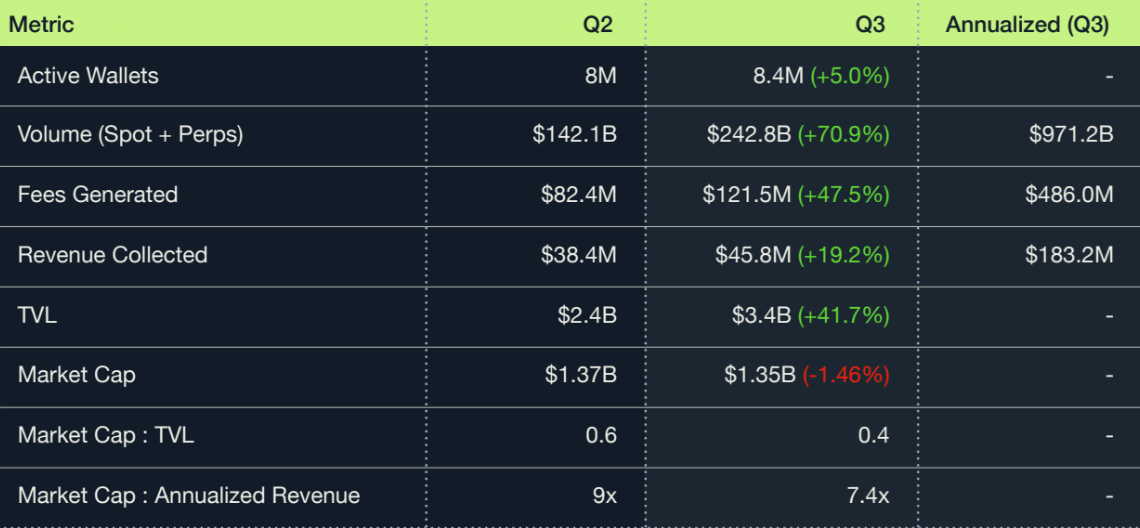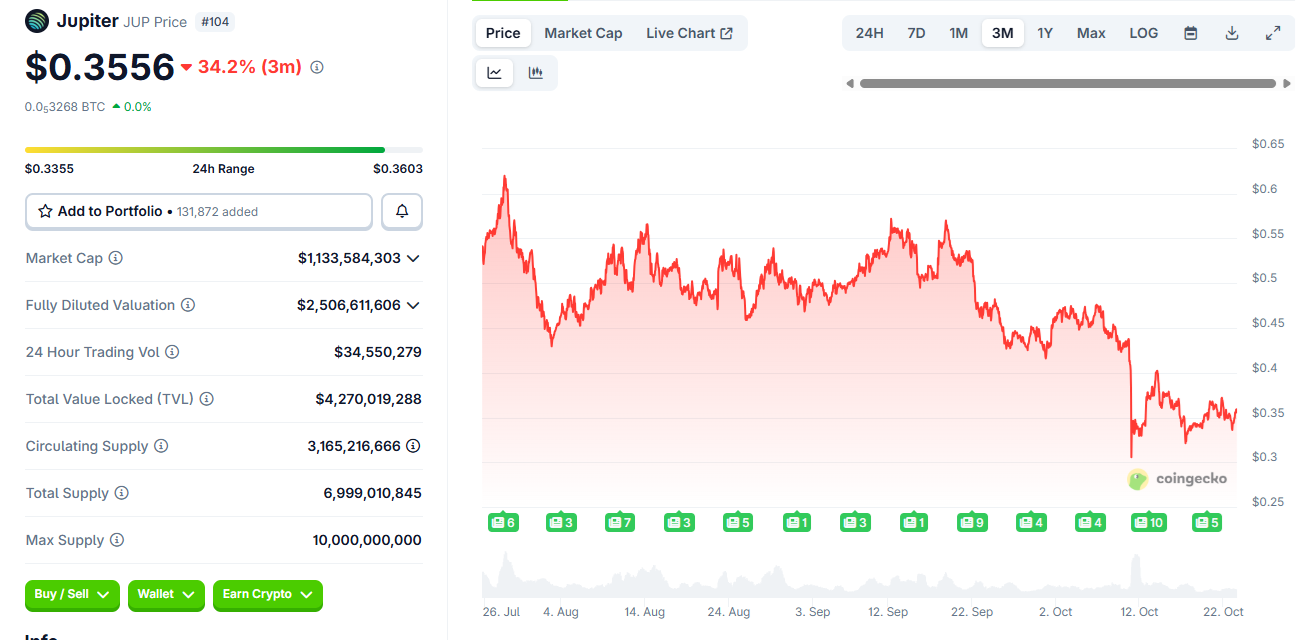Jupiter, a leading DEX aggregator on Solana, generated $46 million in revenues during Q3 2025, driven by surging trading volumes and perpetual futures. This marks a sustainable milestone for the platform, with 8.4 million active wallets and $176.8 billion in spot trading, highlighting its dominance in Solana’s DeFi ecosystem.
-
Jupiter’s Q3 revenues hit $46 million, fueled by Solana’s trading boom and diversified services like perpetual futures.
-
The platform saw 8.4 million active wallets, a rise from 8 million in Q2, underscoring growing user adoption.
-
Perpetual futures contributed $24.6 million, with total annualized fees reaching $1.38 billion, positioning Jupiter as Solana’s top app by revenue.
Discover how Jupiter achieved $46M in Q3 revenues on Solana amid trading surges. Explore sustainable DeFi growth, token performance, and superapp expansions in this in-depth analysis. Stay ahead in crypto—read now for key insights!
What Are Jupiter’s Q3 Revenues on Solana?
Jupiter’s Q3 revenues on Solana reached an impressive $46 million, reflecting the platform’s robust performance amid a trading boom on the blockchain. This figure stems from a mix of native DEX operations, aggregation services, and emerging features like perpetual futures, which alone generated $24.6 million. Without relying on external funding, Jupiter has established a self-sustaining model that supports ongoing development and user growth.
 Jupiter improved its revenue flows from multiple activities, based on its new products turning it into a Solana super-app. | Source: Jupiter Q3 report
Jupiter improved its revenue flows from multiple activities, based on its new products turning it into a Solana super-app. | Source: Jupiter Q3 reportThe platform’s success is evident in its metrics: as of the end of Q3, Jupiter processed $176.8 billion in spot trading volumes, largely boosted by demand for meme tokens. Daily fees recently hit $4.1 million, placing Jupiter among the top five fee-generating apps on Solana, nearing competitors like Hyperliquid. This financial stability allows the team to focus on innovation rather than fundraising, as noted in Jupiter’s quarterly report, which emphasizes long-term DeFi scalability.
Experts in the DeFi space, such as analysts from Messari, have highlighted Jupiter’s role in Solana’s ecosystem growth. “Jupiter’s revenue model exemplifies how aggregators can evolve into comprehensive platforms, capturing value from high-volume trading without compromising decentralization,” one report states. With Solana’s transaction speeds enabling efficient operations, Jupiter’s fees—annualized at $1.38 billion—demonstrate its position as the blockchain’s premier application.
Looking deeper, the revenue breakdown reveals strategic diversification. Spot trading and aggregation remain core, but the introduction of perpetual futures has been transformative, accounting for over half of Q3 earnings. This aligns with broader market trends where derivatives trading on layer-1 chains like Solana is expanding rapidly. Jupiter’s 8.4 million active wallets in Q3, up from 8 million in the prior quarter, signal sustained user engagement, particularly among retail traders seeking low-cost, high-speed swaps.
How Has Jupiter Expanded as a Solana Superapp?
Jupiter’s evolution from a simple DEX aggregator to a full-fledged Solana superapp has been marked by strategic expansions, including validator status and new product launches, all contributing to its $3.28 billion total value locked. In Q3, the platform secured third-largest validator position on Solana by staking over $1 billion, generating $531,400 in revenues from its JupSOL token, which feeds into DAO reserves for community-driven initiatives.
Supporting data from Jupiter’s Q3 report shows the lending business as a key growth driver, locking in significant liquidity alongside DEX pools. The launchpad feature further amplified activity, hosting over 34,000 token launches and facilitating $1.32 billion in trading volumes—though it trails leaders like Pump.fun in meme token dominance. These additions not only diversify revenue streams but also enhance user retention by offering an all-in-one DeFi experience.
Industry observers, including quotes from Solana Foundation representatives, praise this multi-service approach. “Platforms like Jupiter are pivotal in making Solana accessible for everyday users, blending trading, staking, and launching into seamless workflows,” one expert noted in a recent analysis. Short sentences underscore the impact: Validator rewards stabilize operations. Lending protocols attract institutional interest. Launchpad volumes indicate vibrant community participation. Overall, these elements position Jupiter to capture a larger share of Solana’s $50 billion-plus DeFi market.
Furthermore, Jupiter’s focus on sustainability is clear. By avoiding external funding rounds, the team channels revenues into product enhancements, such as improved perpetual futures interfaces that saw accelerated adoption into Q4. Statistical projections from the report suggest DeFi activity on Solana could multiply by 10 in the coming years, with Jupiter poised to lead through its integrated ecosystem. This superapp model reduces fragmentation, allowing users to trade, stake, lend, and launch tokens without leaving the platform.
The platform’s daily operations reflect this maturity. On October 23, fees totaled $4.1 million, driven by spot volumes amid meme token frenzies. As Solana’s trading infrastructure matures, Jupiter’s role in aggregating liquidity across protocols ensures efficient pricing and minimal slippage, benefiting traders ecosystem-wide.
Frequently Asked Questions
What Factors Drove Jupiter’s $46 Million Q3 Revenues on Solana?
Jupiter’s $46 million in Q3 revenues stemmed primarily from perpetual futures ($24.6 million) and spot trading volumes of $176.8 billion, boosted by Solana’s meme token surge. Active wallets grew to 8.4 million, reflecting strong adoption without new funding. This self-sustaining model highlights the platform’s efficiency in capturing DeFi fees.
How Is Jupiter’s JUP Token Performing Amid Strong Platform Revenues?
Hey, if you’re wondering about Jupiter’s JUP token right now, it’s trading around $0.35 as of late October, near a three-month low despite the platform’s solid earnings. Factors like token unlocks and reward sales are adding pressure, but the team plans to enhance JUP’s utility in governance and revenue sharing to reverse the slide and better align it with Jupiter’s growth.
 JUP did not reflect the successful revenues of the Jupiter app. The team announced it would try to boost the roles for the token, with the goal of ending the long-term slide. | Source: Coingecko
JUP did not reflect the successful revenues of the Jupiter app. The team announced it would try to boost the roles for the token, with the goal of ending the long-term slide. | Source: CoingeckoWhat Role Does Jupiter Play in Solana’s DeFi Ecosystem?
Jupiter serves as a leading aggregator and DEX on Solana, routing trades for optimal pricing and now expanding into perpetuals, lending, and token launches. With $3.28 billion TVL and top validator status, it drives efficiency and liquidity, making Solana more competitive against centralized exchanges.
Key Takeaways
- Sustainable Revenue Model: Jupiter’s $46 million Q3 earnings from diversified sources like perpetual futures and spot trading eliminate the need for external funding, ensuring long-term stability.
- User Growth Surge: Reaching 8.4 million active wallets and $176.8 billion in volumes, the platform benefits from Solana’s high-speed environment, particularly meme token trading.
- Superapp Expansion: As a top validator with $1 billion staked and new lending/launchpad features, Jupiter aims to grow DeFi adoption by 10x, offering integrated services for broader trader access.
Conclusion
Jupiter’s Q3 revenues on Solana, totaling $46 million, underscore the platform’s maturation into a sustainable DeFi powerhouse, blending Jupiter Solana revenues from trading, perpetuals, and emerging superapp features like lending and launchpads. Despite JUP token pressures near $0.35, strategic shifts toward enhanced utility signal recovery potential. As DeFi catches pace with centralized markets, Jupiter’s innovations position it for exponential growth—traders should monitor its expansions for opportunities in Solana’s thriving ecosystem.





